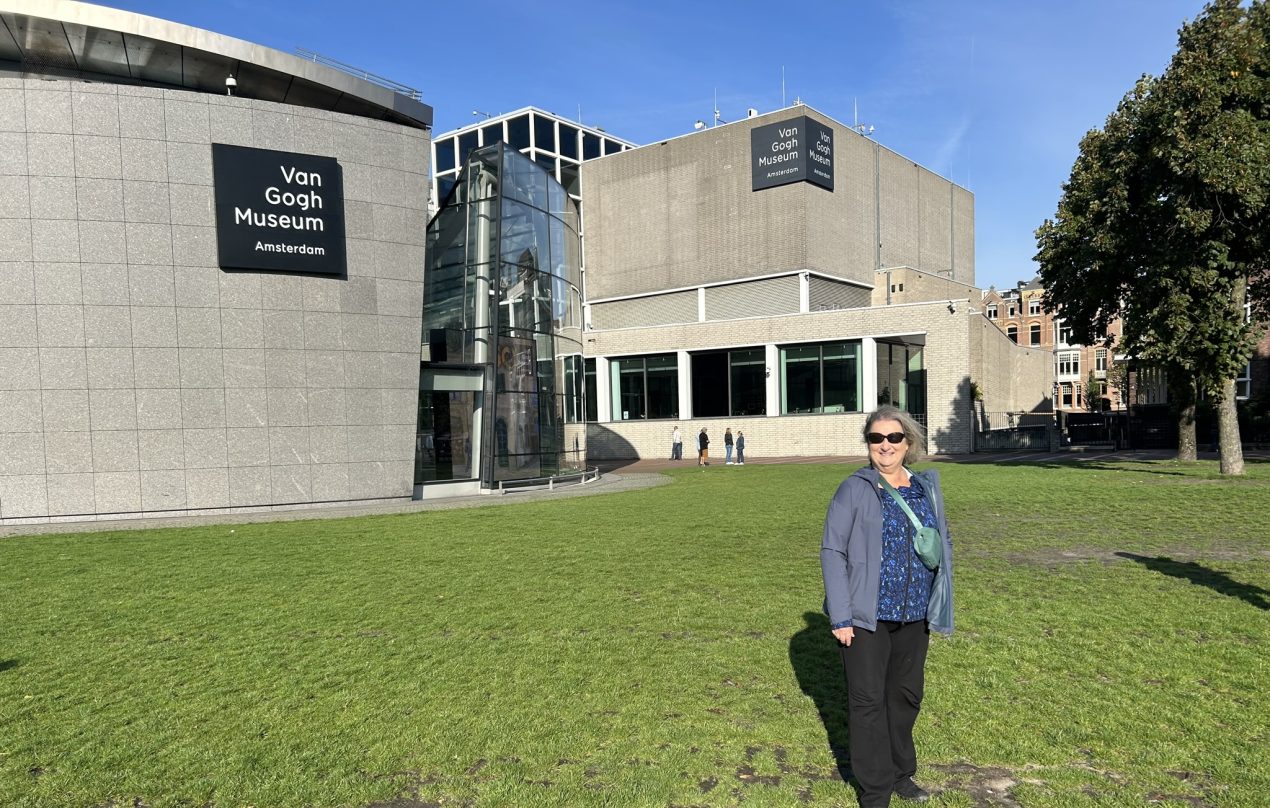Van Gogh Museum in Amsterdam: Best Bets for the Artsy Traveler
I remember the first time I saw the Van Gogh Museum, almost 50 years ago. Compared to the gingerbread façade of its neighbor, the Rijksmuseum, the Van Gogh Museum is sleek and modern, and when I first saw it in 1974, it was fringed with massively tall sunflowers. I burst out laughing. How appropriate!
The Van Gogh Museum houses the world’s most extensive and lovingly presented collection of work by the Netherlands’s fave artist–Vincent van Gogh.
During his lifetime, van Gogh didn’t get much love from his home country, but that oversight has been more than made up for in recent decades. Vincent van Gogh, who barely sold a painting during his life, is big business now.

Ovcrview
In this post, I share my favorite pieces at the Van Gogh Museum, a must-visit for Amsterdam-bound artsy travelers, although make sure you reserve well in advance (more on that later).
The map below shows the location of the Van Gogh Museum in Amsterdam’s Museumplein, easily reached from the Centrum via trams 2 or 12.
Also shown is the location of the Rijksmuseum next door, and the location of the charming apartment I stayed in on tiny Sint Nicholastraat in the lively Centrum area. Called Here’s Lucy, it’s highly recommended if you’re looking for a private one-bedroom apartment and a much better deal than any hotel I’ve ever stayed at in Amsterdam. It’s situated not far from the Central Station and the Damrak is pretty much perfect.
Overview of the Van Gogh Museum
As the name suggests, the Van Gogh Museum is dedicated to exhibiting and celebrating the work of Vincent van Gogh, one of the world’s most beloved artists.
It opened in 1973, three years after my first visit to Amsterdam and a year before my second visit to Amsterdam at the age of 18. I remember being so excited to tour the museum in 1974 when I was already a firm van Gogh fan.
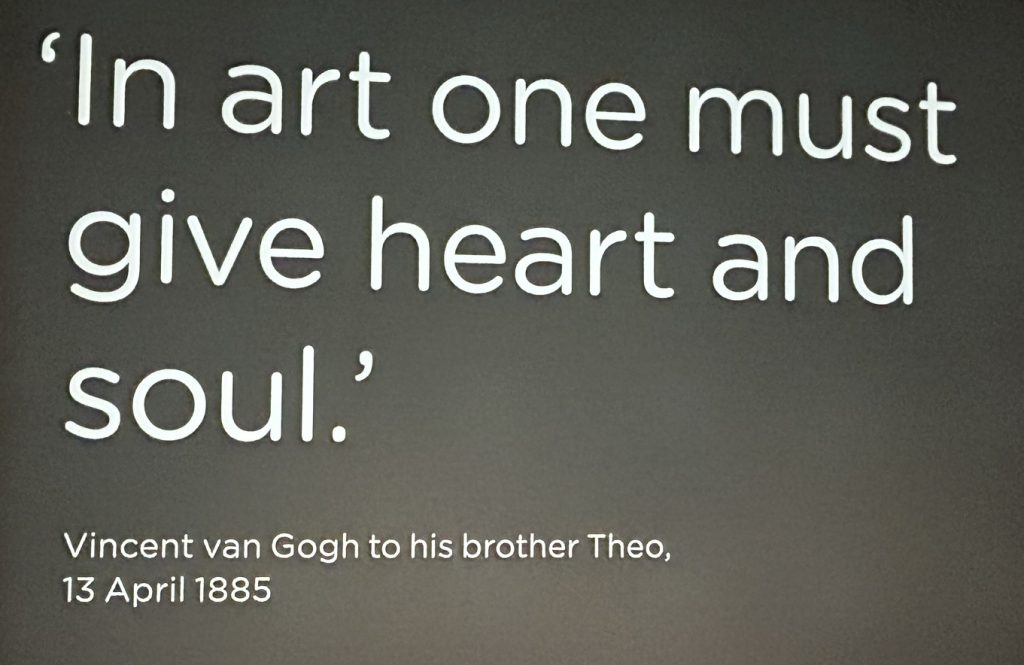
The museum is the most visited museum in the Netherlands, and one of the top most-visited museums in the world. And no wonder! The collection is organized across four floors and includes pieces from several of van Gogh’s contemporaries, including Monet, Gauguin, Pissarro and others.
The intention is to show van Gogh’s work in context and according to various themes, including self-portraits, early work, landscapes, and portraits.
Van Gogh provided hundreds of paintings and drawings over the course of just one decade, from 1880 to 1890. The collection at the Van Gogh Museum shows van Gogh as an artist intent on improving himself and his art while also being deeply engaged with the artistic developments of his day.
View of the Museum
A central atrium extends from the ground floor to the fourth floor and is dominated by a staircase and projections of details from van Gogh’s paintings that change regularly. The exhibition spaces run around three sides of the building.
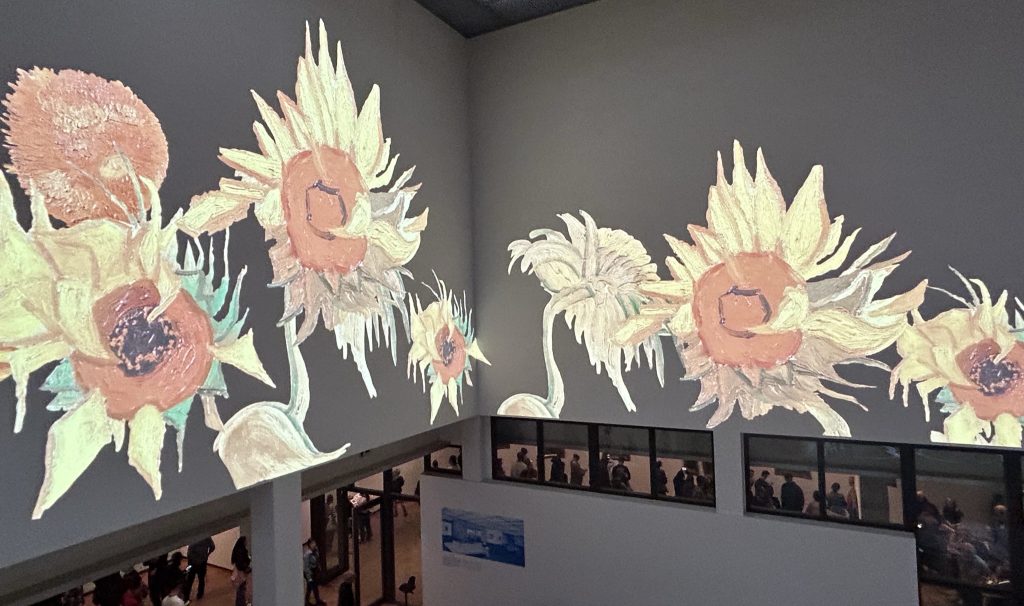
Self-Portraits of Van Gogh
The first room we entered featured a good collection of van Gogh’s self-portraits. I include two of my favorites. I like the contrast in how he handled the brushstrokes in these two works, and the intensity of his stare.
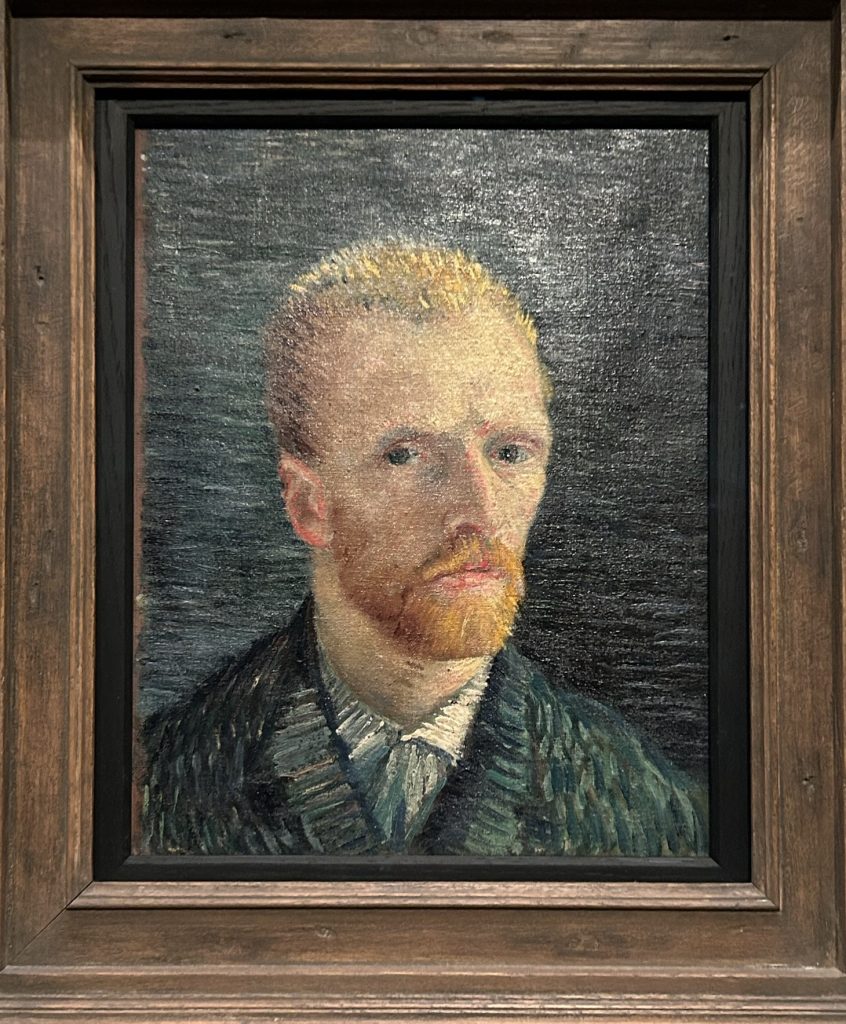
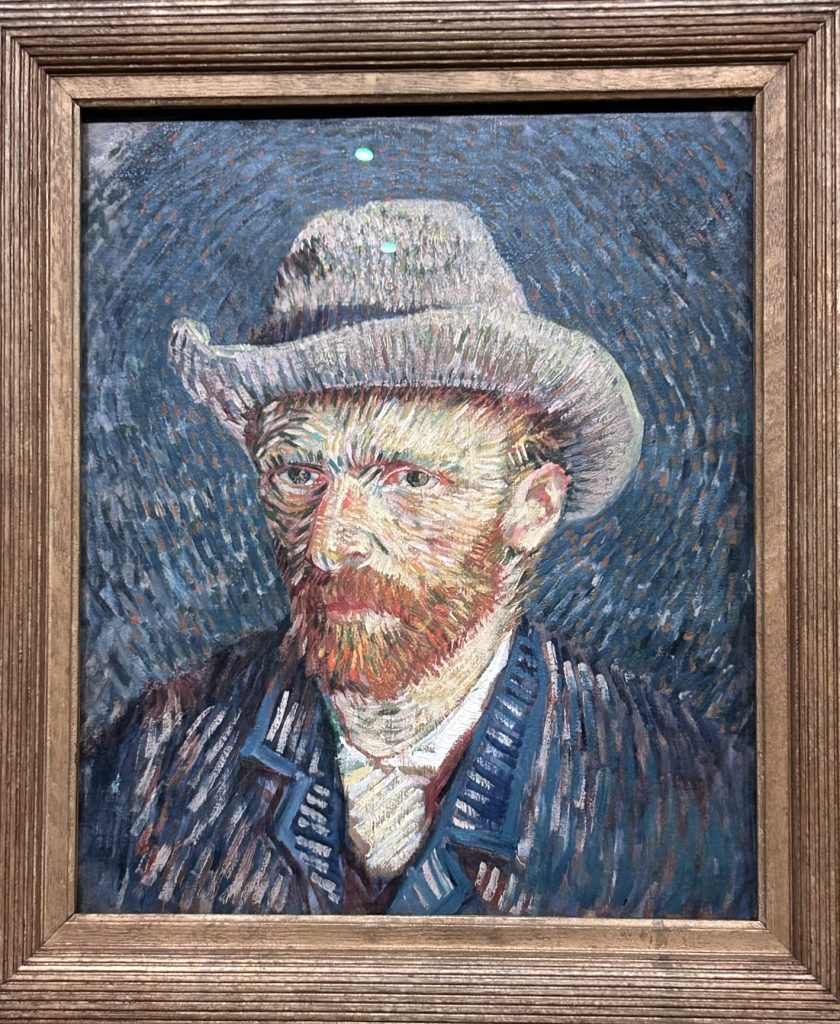
Van Gogh didn’t start painting seriously until he was 27 when he set to work to learn the rudiments of painting, mostly by studying the art of other artists. He was a great admirer of French 19th-century painters such as Jean-Francois Millet and Jules Breton who portrayed peasant life in the countryside.
Early Work
Most of van Gogh’s early work that he completed before he went to Paris and then finally to Provence use a very limited, even dreary palette. They have almost an Old Master feel to them.
Still Life with Open Bible
I particularly enjoyed a painting of his recently deceased father’s bible set next to van Gogh’s copy of La joie de vivre by Emile Zola–a ‘bible’ of modern life. The intention of the painting is to juxtapose the religious and traditional mores of his father with van Gogh’s more modern sensibilities. I was intrigued with how he rendered the open pages of the bible with rough brush strokes.
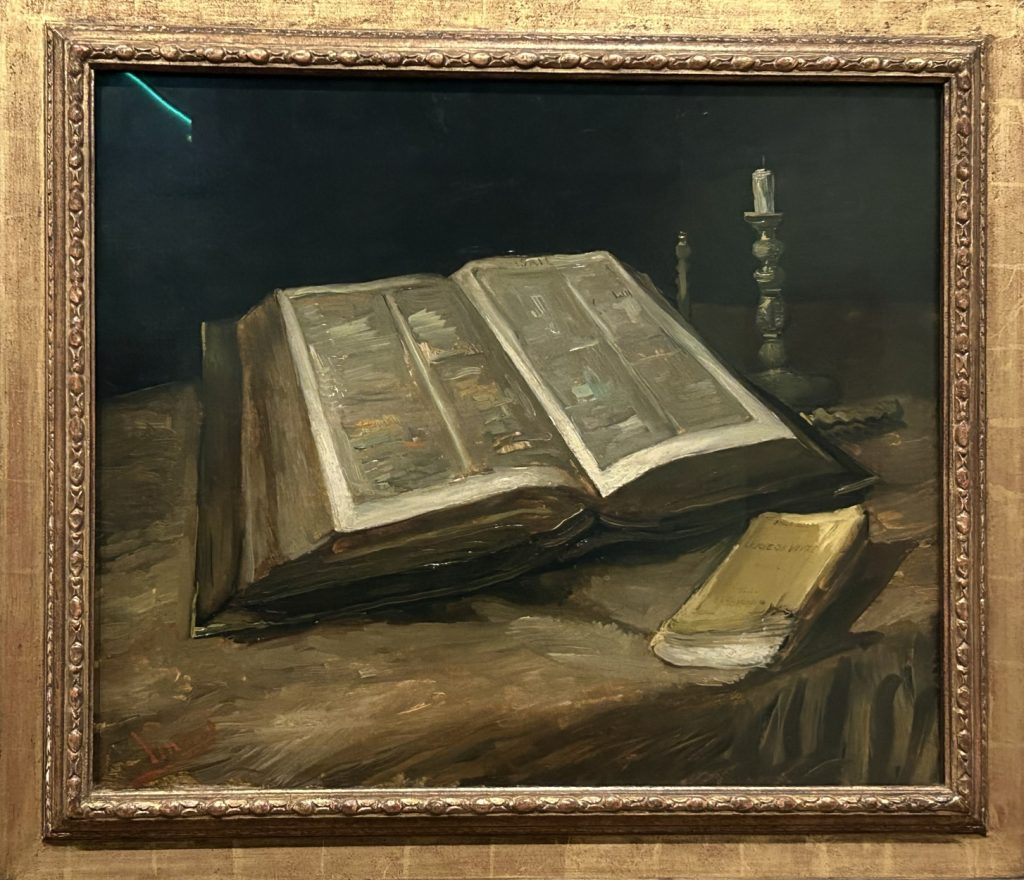
The Potato Eaters
One of van Gogh’s most famous works from his early period is The Potato Eaters. The darkness of the painting and the almost grotesque roughness of the figures exemplifies the harshness, even despair, of peasant life. Van Gogh wrote that a true peasant painting should smell of bacon, smoke, and steaming potatoes.
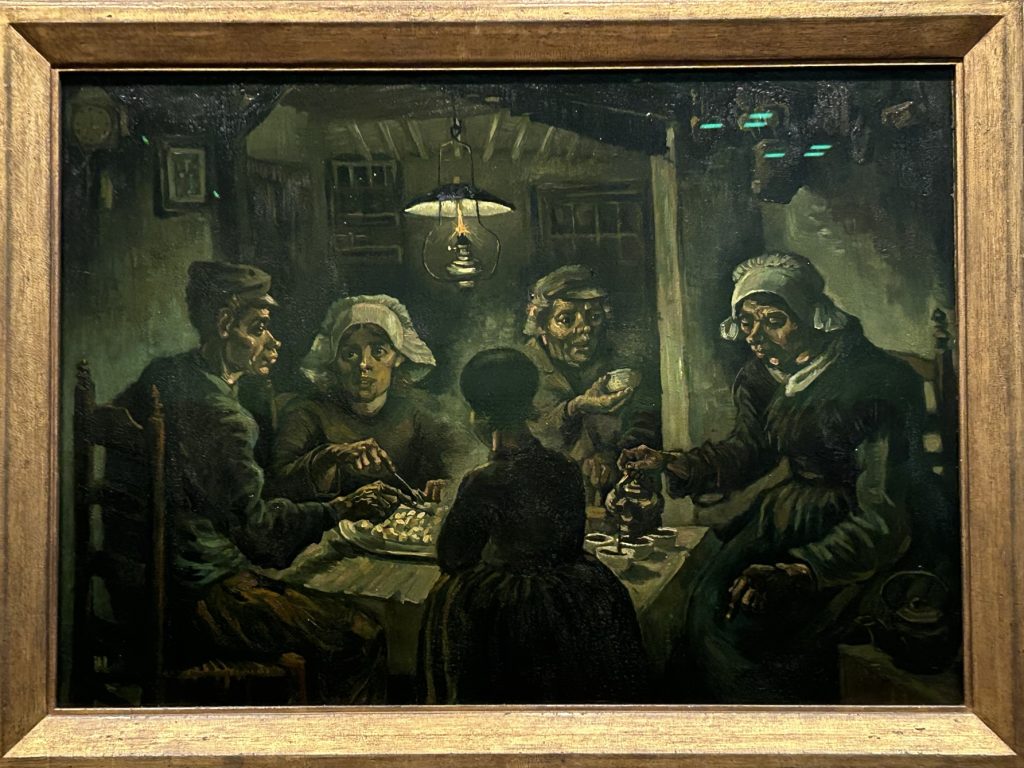
Van Gogh in Paris
The gallery devoted to works that van Gogh created while living in Paris also include several works by his contemporaries, including Monet and Degas.
Nude Bathing by Degas
This nude by Degas is executed in numerous shades of pastel crayon and is one of several nudes that Degas exhibited in Paris and which van Gogh saw and greatly admired.
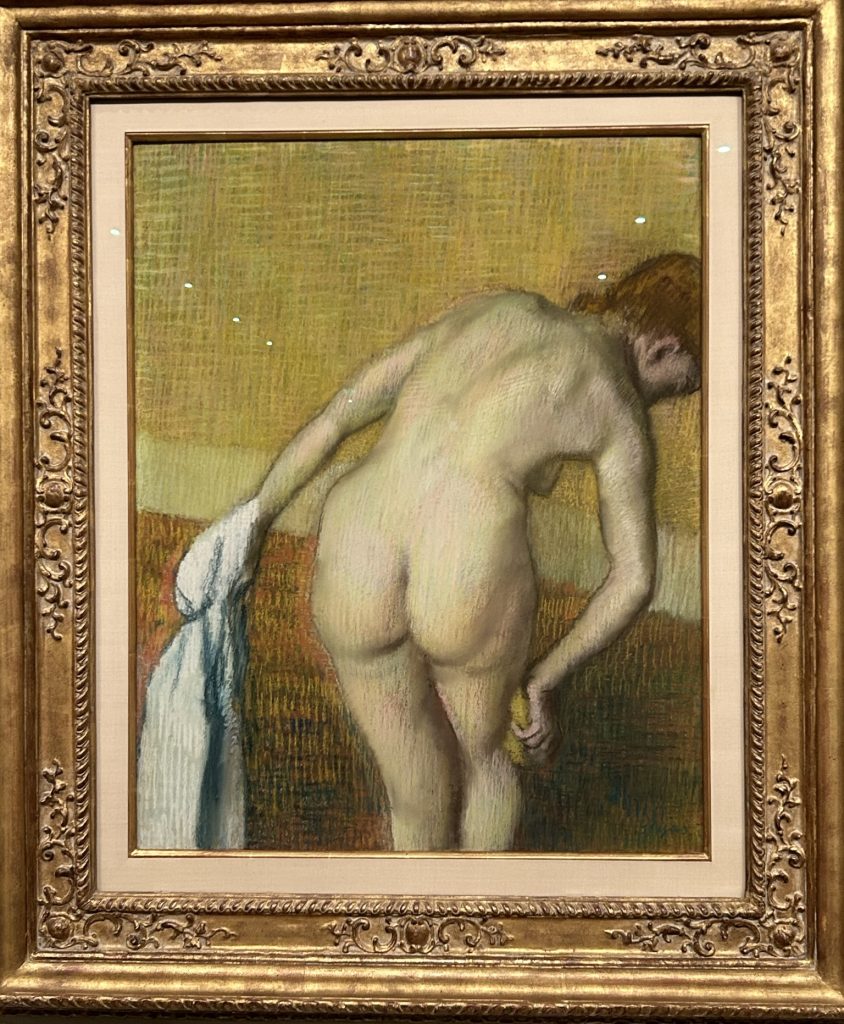
View Seen Through a Balcony by Gustave Caillebotte
Another work by one of van Gogh’s contemporaries is the painting of a Paris street seen through a wrought iron balcony by Gustave Caillebotte. I’ve seen several of Caillebotte’s paintings at the Musée d’Orsay in Paris and like his work.
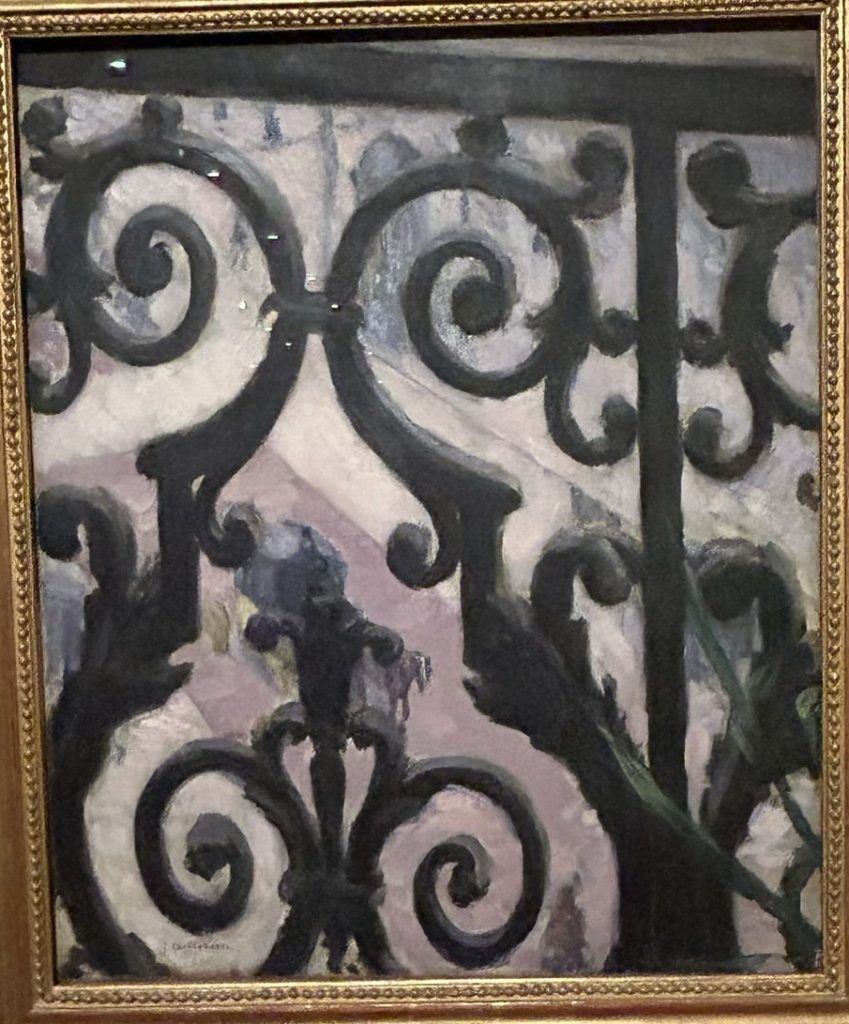
Café Table with Absinthe
And here’s a painting that van Gogh did while living in Paris. It depicts a glass of absinthe in a café. Already his palette is starting to lighten up with more pastel colors and looser brushstrokes.
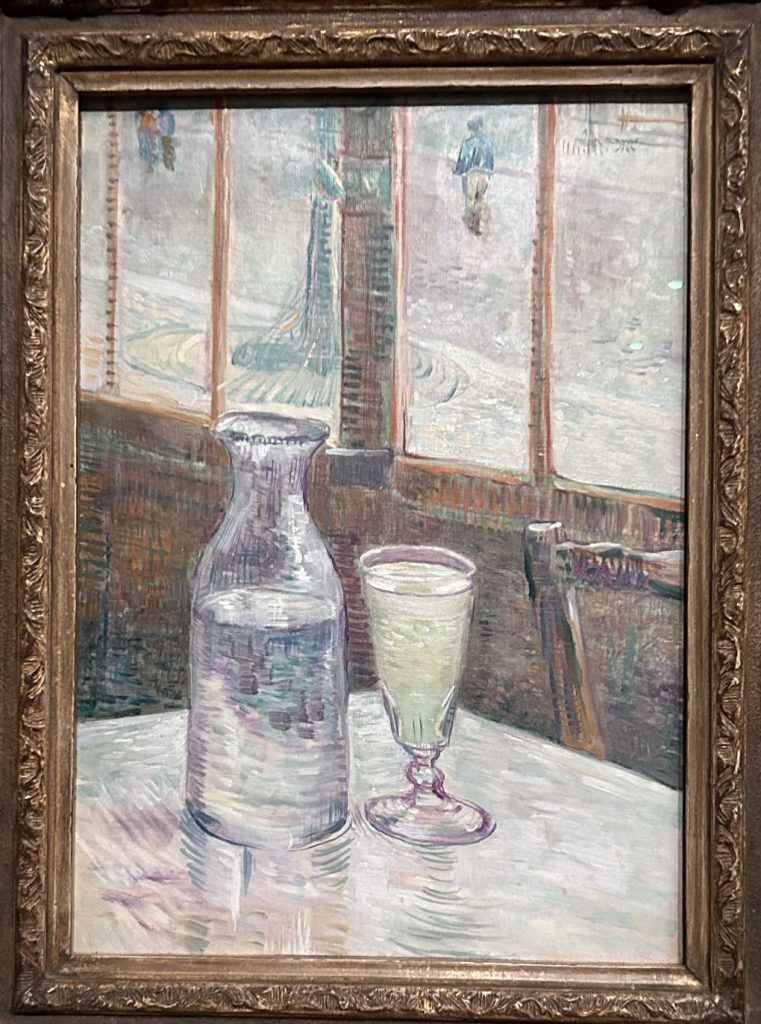
Still Lifes – Red Cabbage and Garlic
I don’t associate van Gogh with still life paintings except, of course, for his flower paintings. This painting of red cabbages and onions is a revelation. I love the blue, red, and gold palette and the vibrancy of his brushstrokes. This still life is anything but still. Van Gogh was apparently intent on studying color contrasts in the painting–the complementary colors of yellow and blue reinforcing each other. He was well aware of color theory and how different color combinations work together to produce different effects and even emotions.
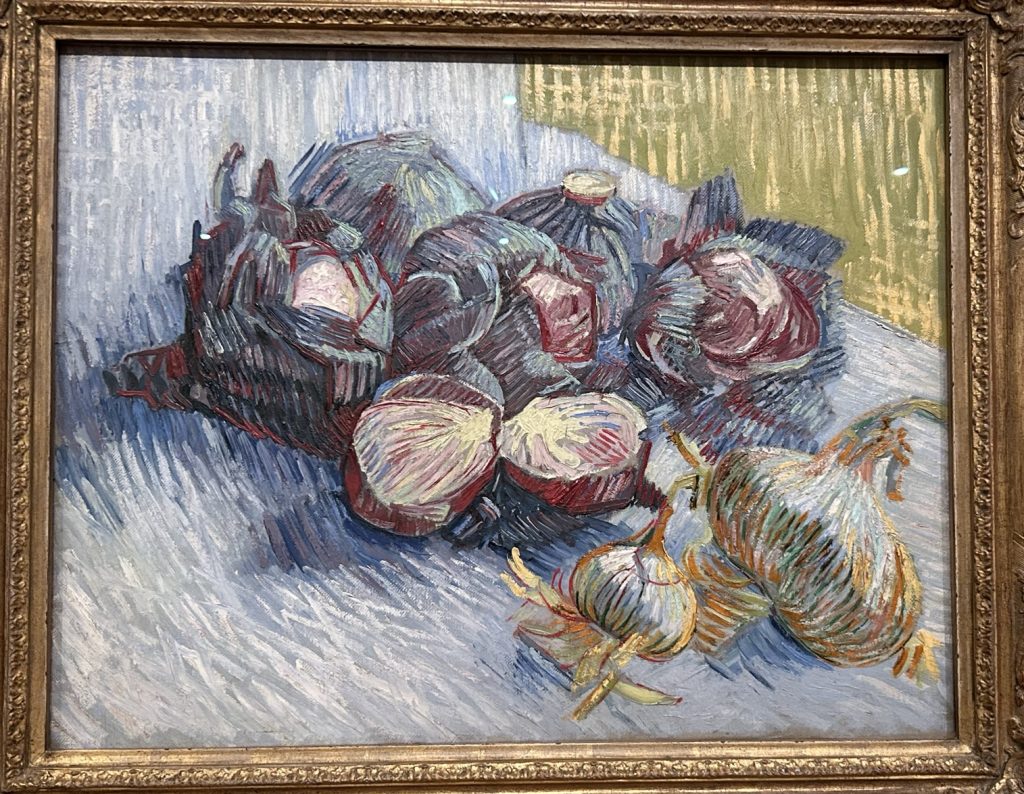
Portraits
Several of van Gogh’s most famous paintings are portraits of people he met and interacted with–regular people such as a bar maid, a postman, and his landlord. The Van Gogh Museum includes a few of his portraits, although not any of the super famous ones.
Woman in the Bar
This painting of a solitary woman in a Paris café is a great example of how van Gogh used regular people he encountered every day as his models. The look on her face is so relatable–staring into the middle distance, lost in her own thoughts. Is she annoyed? Pensive? Or just bored?
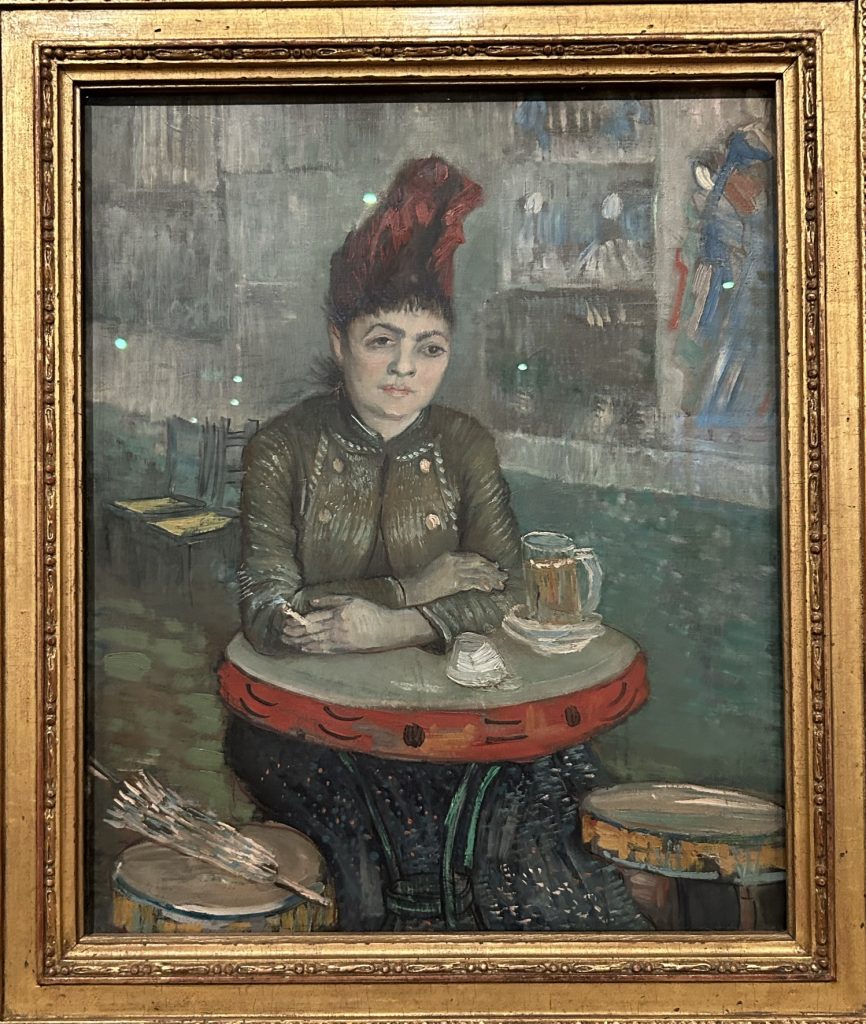
Van Gogh in the South of France
Van Gogh left bustling Paris for the south of France in late winter, arriving just as the trees were beginning to blossom.
The White Orchard
Here is one of three paintings he did not long after arriving in Arles. I’m entranced by the movement of the trees and the joyous freedom of the brushstrokes. It’s as if van Gogh’s been released from prison and poised on the edge of a whole new adventure, which indeed he was.
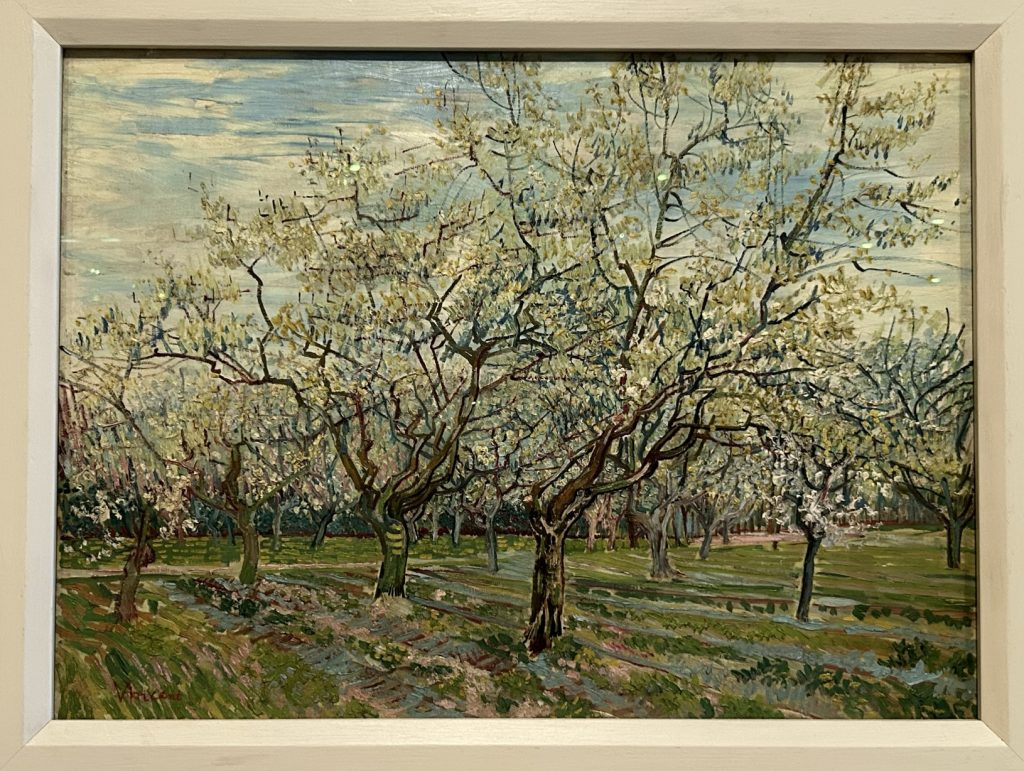
The Harvest
I felt very verklempt when I saw this painting, the very first van Gogh I ever saw and the first painting that launched me into a lifetime of loving art. I saw it at Expo 67 in Montreal when I was 11. A pretty uneventful childhood spent in Vancouver had not prepared me for modern art. I was blown away, first by The Harvest by van Gogh and then in the same exhibition at Expo 67 Lavender Mist by Jackson Pollock. It’s kinda no wonder I’ve ended up spending my life with a painter!
The Harvest makes me feel happy every time I see it. I’m not sure why. Perhaps it’s the bands of color and texture or maybe the balancing of the complementary colors of gold and blue. It just feels totally right. I look at it and I feel glad to be in the world.
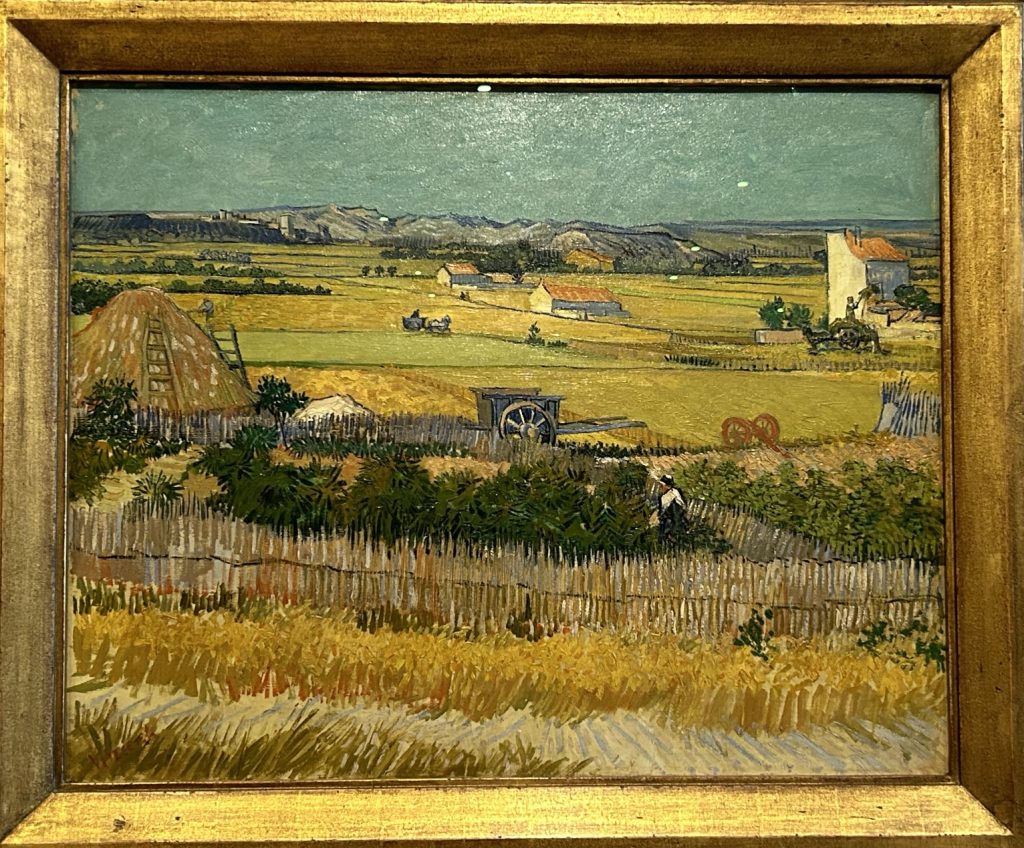
The Bedroom
How many times have I seen this iconic piece in reproductions and on mugs and mousepads, puzzles and pens? And yet seeing it in “real life” is still a thrill. There’s something so endearing about a man who paints his humble little bedroom and manages to infuse it with such warmth and loneliness. And again, it’s his use of complementary yellows and blues that makes the painting so satisfying to look at.
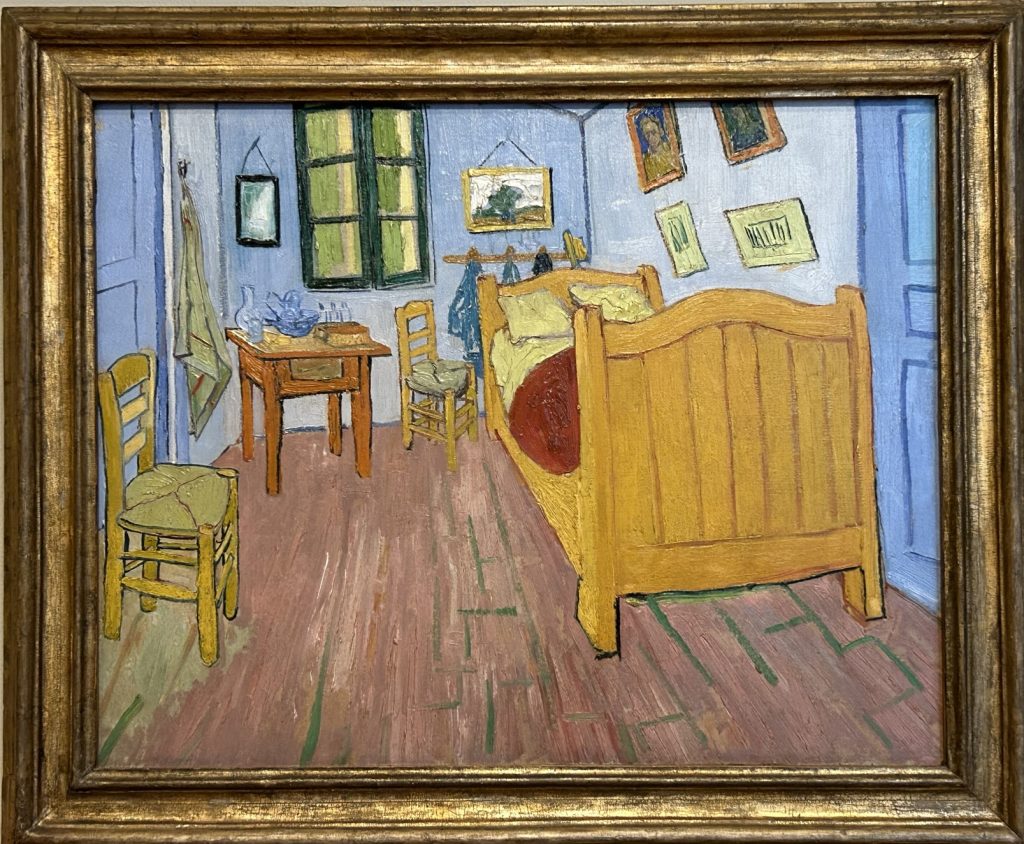
Sunflowers
And another iconic favorite! Composed of just three shades of yellow, this Sunflowers (he painted several versions) glows like lemons in the sun. The sunflowers are in various stages of dying and yet the painting is beguilingly cheerful.
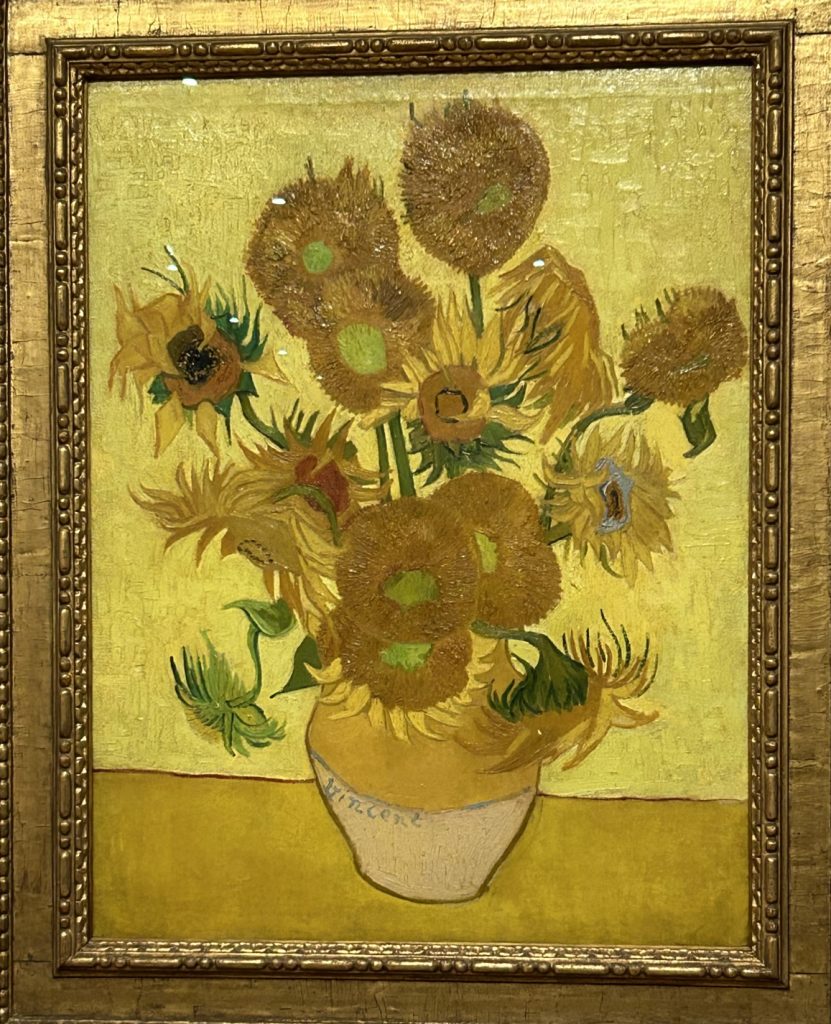
The Yellow House
And here’s yet another study in blues and yellows! Gosh, he’s good. Van Gogh manages to capture heat shimmering against the walls of the houses in Arles. He was hoping to turn his yellow house into an artist colony but only Gauguin came, and only stayed two months. Poor Vincent led a rather solitary existence.
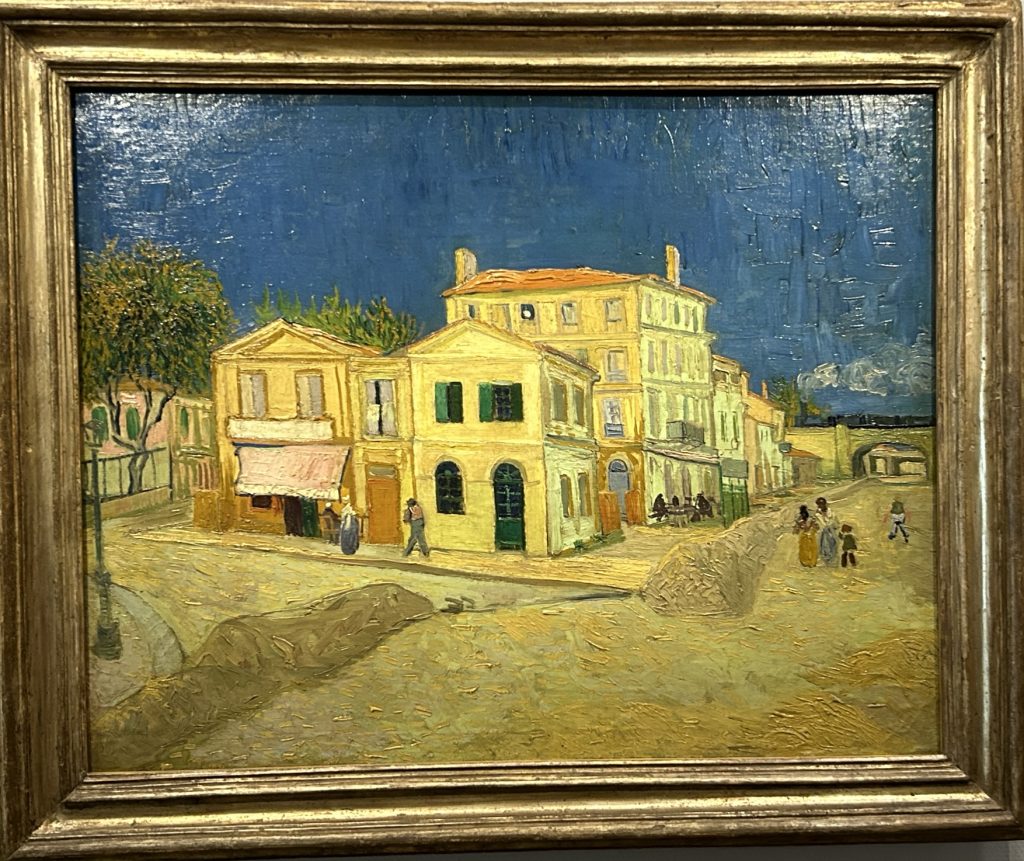
Japanese Influence
Van Gogh was a huge fan of Japanese art, as were many of his contemporaries, and several pieces were directly influenced by it.
Almond Blossoms
He painted this gorgeous, Japanese-print-inspired piece depicting almond blossoms against a blue sky to celebrate the birth of his nephew and namesake, Vincent–the son of his beloved brother, Theo. It’s almost abstract in its focus only on the blossoms and the sky with no other landscape elements. Van Gogh himself recognized the piece as one of his best–and he wasn’t wrong!
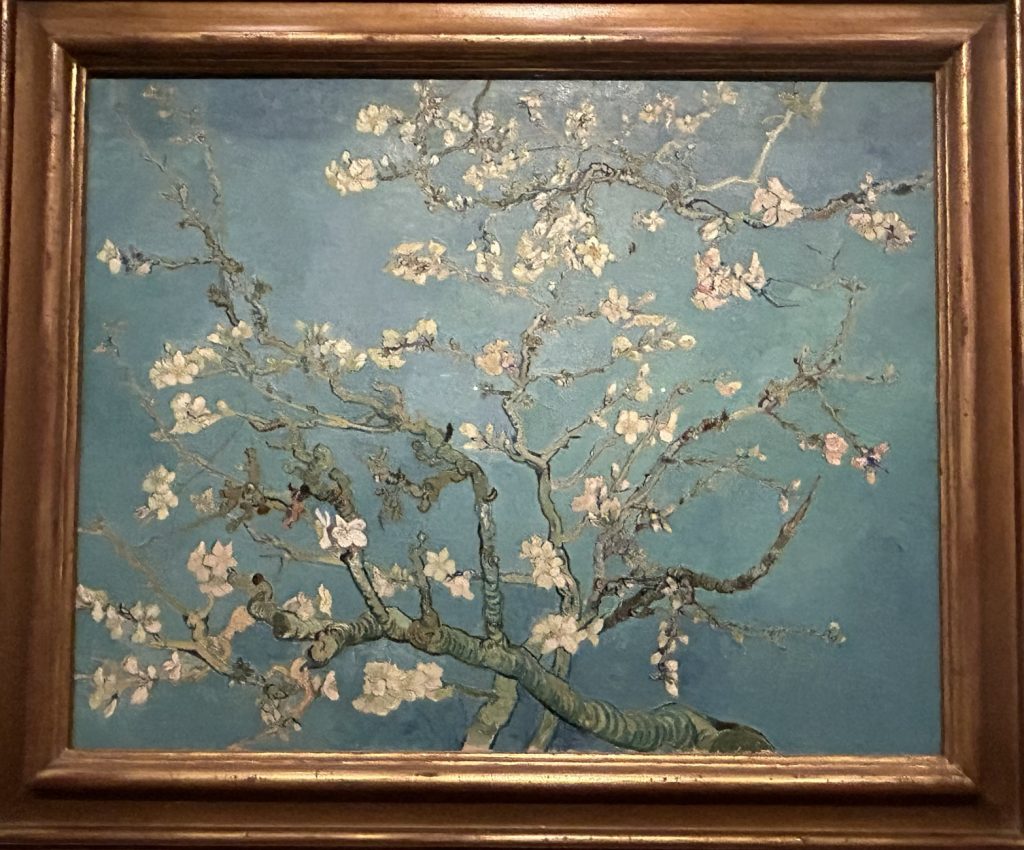
The Sower
And finally, here is The Sower, one of van Gogh’s smallest and yet most well-known paintings. It has so much movement and energy. I can sense the man purposefully planting his seeds, completely trusting that they will come up in the spring. In this painting, the sky is green instead of blue which casts an eerie glow over the scene, giving it an almost foreboding look, although the sower seems oblivious to anything beyond the sowing of his seeds.
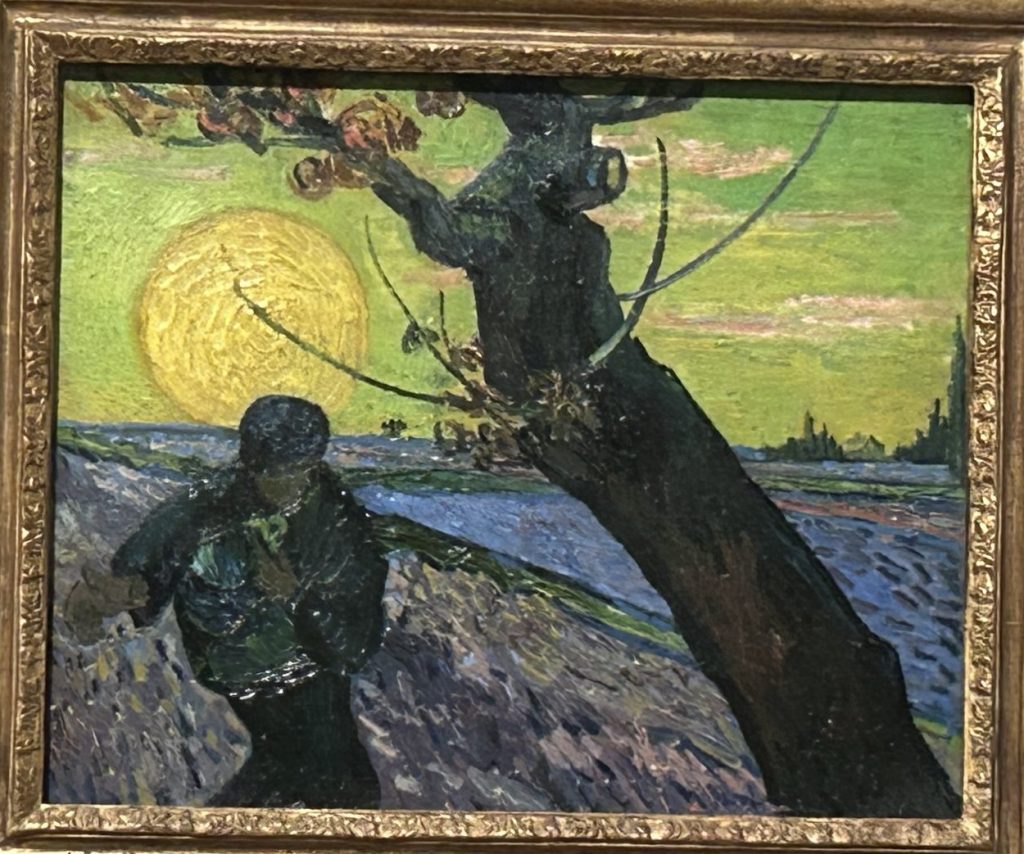
,
Practical Information
The Van Gogh Museum sells out many days in advance. Get your tickets online at least two weeks before you plan to travel to Amsterdam (possibly more during the busy summer months). Most visitors appear to get the audioguide which probably enhances the viewing experience. We did not, preferring to discuss the pieces as we looked at them. Every so often, you can discreetly eavesdrop on a guided tour. All of the ones I came across the morning we toured the museum were in English. Click one of the options below to purchase your ticket.
Tour Options
Conclusion
The Van Gogh Museum is well worth several hours of your time on even the shortest visit to Amsterdam. The only downside is that the world holds millions of van Gogh lovers and even with daily limits on visitors, a good chunk of them will be at the museum at the same time you are.
It does get tiring dodging the crowds, particularly if you enjoy taking photos of the pieces like I do and also read all the captions.
Most people are listening to audio guides and sometimes stand immobile for long periods in front of each painting. When several of them are congregated in front of a parituclarlty popular piece such as The Sunflowers, you’ll have to wait awhile to get your viewing turn.
But hey, it’s worth it. These are original paintings by Vincent Van Gogh! Artsy traveling doesn’t get much better. And when you’re done, you can tour no fewer than three gift shops (there may have been more) loaded to the gunnels with van Gogh schlock. On this trip I resisted, but I do own a very nice van Gogh pen that I purchased on a previous visit.
Have you visited the Van Gogh Museum? What are some of your favorites? Share in the comments below.
